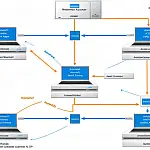A Beginner's Guide to Building a REST API in C#Do you want to create a REST API in C# but don't know where to begin? This beginner's guide will assist you. Follow our step-by-step tutorial and you'll be a pro in no time!
This article is part of a series of articles. Please use the links below to navigate between the articles.
- A Beginner's Guide to Building a REST API in C#
- Using Swagger to Document and Test Your C# REST API
- How to Add Authentication and Authorization to C# REST APIs
- Error Handling and Exception Management in C# REST APIs
- Data Validation and Error Handling in REST APIs using C#
- Versioning Your C# REST API: Best Practices and Approaches
- Caching Strategies for Improved Efficiency in C# REST APIs
- How to Implement Rate Limiting in Your C# REST API
If you're new to REST API development in C#, this beginner's guide is a great place to start. You'll learn the fundamentals and become proficient in no time with a step-by-step lesson. Whether you're a developer trying to broaden your knowledge or a newcomer looking to get started with API programming, this tutorial has you covered.
We will cover the basic concepts of REST and APIs in this beginner's guide, including REST principles, HTTP methods, status codes, and data formats. By the end of this article, you will have a firm grasp of the fundamentals and be ready to begin developing your REST API in C#.
Understand the Basics of REST and APIs
Before starting to build a REST API in C#, it's important to understand the fundamentals of REST and APIs. REST is an architectural methodology for creating networked applications that stands for Representational State Transfer. It is founded on a set of rules and limitations that enable clients and servers to communicate in a scalable and stateless manner.
An API, or Application Programming Interface, is a collection of rules and protocols that enable various software applications to communicate with one another. APIs specify the techniques and data formats that can be used to communicate with a specific software system.
Understanding the fundamentals of REST and APIs will help you design and develop your REST API in C# in a way that is efficient, scalable, and adheres to best practices. It will also assist you in comprehending how to consume APIs in your apps.
Set Up Your Development Environment
You must first set up your development environment before you can begin developing your REST API in C#. To get started, follow these steps:
- Download and install Visual Studio: Visual Studio is a well-known integrated development environment (IDE) for C# development. The most recent version of Visual Studio can be downloaded from the Microsoft website.
- Select a Framework: C# provides numerous frameworks for developing REST APIs, including ASP.NET Core and ASP.NET Web API. Select the framework that best meets your requirements and install it with the Visual Studio installation.
- Start a New Project: Launch Visual Studio and start a new project. Choose the proper project template for your framework (for example, ASP.NET Core Web API).
- Configure Your Project: After you've created your project, you may need to configure additional options. Setting up a database connection, defining authentication and authorization, or specifying routing rules are all examples of this.
- Install Dependencies: Depending on the needs of your project, you may need to install additional packages or libraries. To simply add and manage dependencies, use NuGet, the.NET package manager.
- Write Your Code: It is now time to begin writing your code. Define your API endpoints, models, controllers, and any other components that are required. To guarantee that your code is clean, maintainable, and scalable, adhere to best practices and design patterns.
- Test Your API: Testing is a necessary step in the development process. Test your API endpoints with tools like Postman or Swagger to confirm they are working properly.
- Deploy Your API: Once you're happy with your API, it's time to put it into production. This could be a local server, a cloud platform like Azure, or your preferred hosting provider.
Create a New C# Project
Open Visual Studio and perform the following steps to create a new C# project:
- Select "File" from the top menu bar.
- Choose "New" and then "Project" from the dropdown menus.
- In the "Create a new project" window, select the REST API development project template. Select "ASP.NET Core Web API" if you're using ASP.NET Core.
- Give your project a name and a location, then press the "Create" button.
- Visual Studio will create the files and folders required for your project.
- Within this project, you can now begin writing code and developing your REST API.
When writing code, remember to adhere to best practices and design patterns to ensure that it is clean, maintainable, and scalable.
Define Your API Endpoints
Before you begin developing your REST API in C#, you must first identify your API endpoints. The URLs that clients will use to connect with your API are known as API endpoints. Each endpoint represents a distinct resource or activity that customers can demand. Consider the many resources and actions that your API will support when creating your API endpoints. If you're designing an API for a blog, you might provide endpoints for creating a new blog post, retrieving a list of blog posts, modifying a blog post, and removing a blog post. Once you've determined which endpoints you require, you can begin implementing them in your C# code.
In your API controller, each endpoint should have a corresponding method that handles the request and delivers the necessary answer. When developing your API endpoints, keep RESTful principles in mind. To signify the action being performed, employ HTTP verbs like as GET, POST, PUT, and DELETE, as well as meaningful URLs that reflect the resources being visited. By establishing your API endpoints ahead of time, you can ensure that your REST API is well-structured and simple for customers to utilise.
What Are The RESTful Principals?
It is important to follow best practices when developing RESTful API endpoints to ensure a consistent and intuitive interface for your API consumers. Here are some pointers for creating RESTful API endpoints.
- Choose resource names that are clear and descriptive. Use "users" rather than "getUsers" and "products" rather than "fetchProducts."
- Resource names should typically be in the plural form, as they represent collections of items. For example, use "/users" instead of "/user" to represent a collection of users.
- Use HTTP Methods for Actions
- Use `GET` to retrieve resource data (e.g., `GET /users`)
- Use `POST` to create a new resource (e.g., `POST /users`)
- Use `PUT` or `PATCH` to update an existing resource (e.g., `PUT /users/1` or `PATCH /users/1`)
- Use `DELETE` to remove a resource (e.g., `DELETE /users/1`)
- Use appropriate HTTP status codes to indicate the result of an API request (e.g., 200 for success, 201 for resource creation, 204 for no content, 400 for bad requests, 404 for not found, etc.).
- Use API versioning and maintain backwards compatibility.
- Follow a consistent URL structure across your API. Avoid arbitrary or complex URL patterns.
- Use hierarchical URLs for nested resources, such as `/users/1/orders/2` to represent an order for a specific user.
- Use query parameters to filter, sort, and paginate results. For example,
/products?category=electronics&sort=price&limit=10&page=2
Implement CRUD Operations
Any REST API must provide CRUD operations, which stand for Create, Read, Update, and Delete. Clients can use these operations to interact with your API and conduct actions on the resources it maintains.
You'll need to add methods in your API controller for each operation to implement CRUD operations in your REST API. You may have a method for generating a new resource, a method for accessing a specific resource, a method for updating a resource, and a method for deleting a resource, for example.
Make sure to handle the correct HTTP verbs while implementing these methods. The method for establishing a new resource, for example, should handle the POST verb, but the method for updating a resource should handle the PUT verb.
You'll need to handle the data sent by the client in addition to the HTTP verbs. When creating a new resource, for example, the client may transmit a JSON object containing the new resource's data. This data should be extracted by your API call and used to generate the resource.
Similarly, when a resource is changed, the client may submit a JSON object with the modified data. This data should be extracted by your API call and used to update the resource.
Example C# Rest API Controller
The following is a simple example of how to use C# and the ASP.NET Core framework to develop a REST API for temperature conversion from Celsius (°C) to Fahrenheit (°F) and vice versa. You can add the following code to your controller in a new ASP.NET Core Web API project. We'll be using this code in future tutorials so it'll be worth setting up a project with this code in.
using Microsoft.AspNetCore.Mvc;
[Route("api/temperature")]
[ApiController]
public class TemperatureController : ControllerBase
{
[HttpGet("celsius-to-fahrenheit")]
public ActionResult<string> CelsiusToFahrenheit([FromQuery] double celsius)
{
double fahrenheit = (celsius * 9/5) + 32;
return Ok($"Celsius: {celsius}°C is equivalent to Fahrenheit: {fahrenheit}°F");
}
[HttpGet("fahrenheit-to-celsius")]
public ActionResult<string> FahrenheitToCelsius([FromQuery] double fahrenheit)
{
double celsius = (fahrenheit - 32) * 5/9;
return Ok($"Fahrenheit: {fahrenheit}°F is equivalent to Celsius: {celsius}°C");
}
} Check that you have the required ASP.NET Core packages installed. Visual Studio or the.NET CLI can be used to construct an ASP.NET Core Web API project.
You can launch the API after you've added the above code to your controller. It will be accessible by default at http://localhost:5000 (or a different URL if you choose one). You can use Postman, curl, or your web browser to test the API.
- To convert 25°C to °F -
http://localhost:5000/api/temperature/celsius-to-fahrenheit?celsius=25 - To convert 77°F to °C: -
http://localhost:5000/api/temperature/fahrenheit-to-celsius?fahrenheit=77
You can see from this example that we defined api/temperature in the controller Route attribute, and celsius-to-fahrenheit and fahrenheit-to-celsius on the HttpGet method attributes.
This is just a basic example, and in future articles, we will extend it by adding error handling, validation, and more advanced features as needed.






